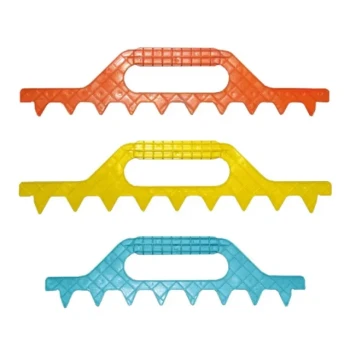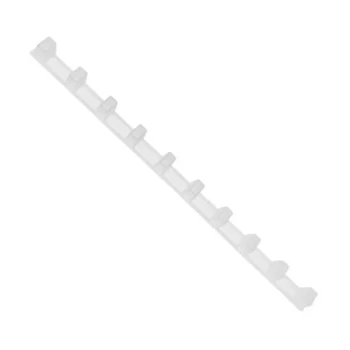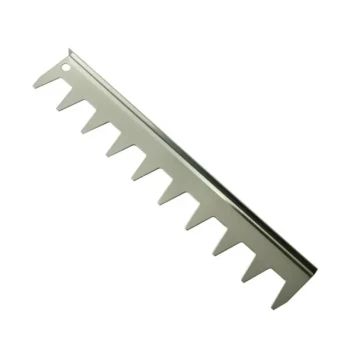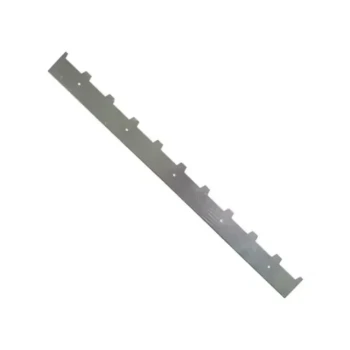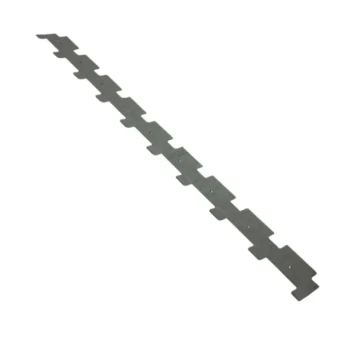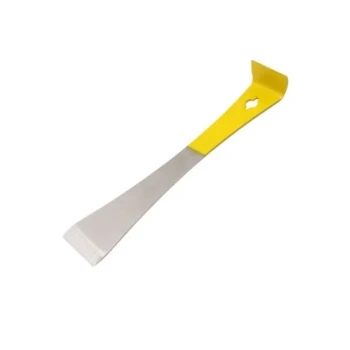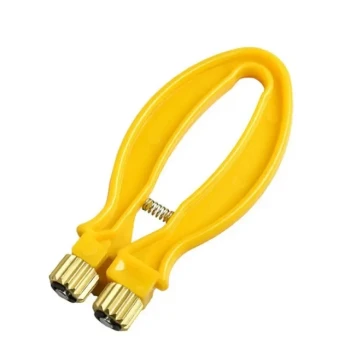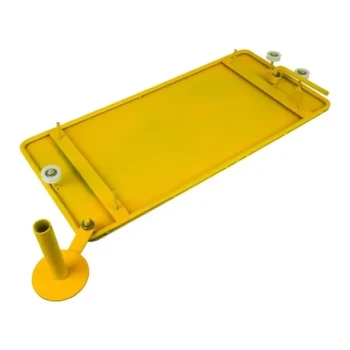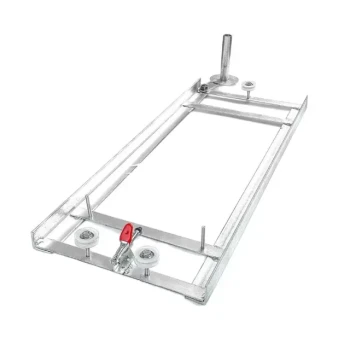When bees build comb between your frames, you must remove it. This misplaced comb, known as burr comb or bridge comb, is a direct signal that the spacing within your hive is incorrect. Removing it and correcting the frame alignment is essential for conducting inspections and maintaining the long-term health of the colony.
The core issue is not the comb itself, but what it represents: a violation of "bee space." Bees build this extra comb because the gap between frames is too large. Your solution involves not just removing the symptom (the burr comb) but curing the disease (the incorrect spacing).
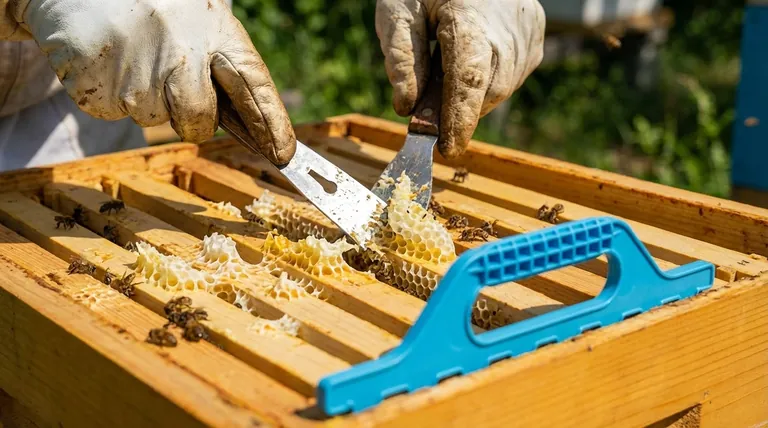
Why Bees Build Comb Between Frames: The Principle of Bee Space
Bees are incredibly precise architects. Their building habits are governed by a core principle that every beekeeper must understand to manage a hive effectively.
Defining "Bee Space"
Bee space is the specific gap—measuring between 1/4 and 3/8 of an inch (6-9mm)—that bees naturally preserve as a pathway. They will keep a gap of this size clear for movement throughout the hive.
When Spacing is Wrong
If a gap is larger than 3/8 of an inch, bees will fill it with comb. This is what happens when you find burr comb connecting frames or connecting a frame to the hive wall.
Conversely, if a gap is smaller than 1/4 of an inch, bees will seal it shut with propolis, a sticky plant resin.
Common Causes of Incorrect Spacing
The most frequent cause of burr comb is simple human error. This typically happens if a beekeeper does not push all the frames tightly together after an inspection, leaving an extra-wide gap somewhere in the hive box. Using fewer frames than the box is designed for (e.g., 9 frames in a 10-frame box) will also inevitably lead to this issue.
A Step-by-Step Guide to Removing Burr Comb
Removing burr comb is a straightforward but essential maintenance task. Acting quickly prevents a small problem from becoming a major one.
Gather Your Tools
You will need your standard hive tool and a smoker. It is also helpful to have a separate container or bucket to place the comb you remove.
Use Smoke to Clear the Area
Before you begin cutting, apply a few gentle puffs of smoke into the gap between the frames. This encourages the bees to move away from the work area, reducing the chance that they will be crushed or agitated.
Carefully Scrape and Remove the Comb
Use the flat end of your hive tool to slice the burr comb away from the top bars of the frames. Work slowly and deliberately. Pry the frames apart slightly and cut away any comb that connects the vertical faces of the frames.
Deal with the Removed Comb
Once removed, inspect the comb. If it contains honey, you can set it aside to be crushed and strained. If it contains drone brood, you can dispose of it or, as some beekeepers do, feed it to chickens. If it is empty, it can be melted down with other wax cappings.
Understanding the Consequences of Ignoring It
Leaving burr comb in the hive might seem harmless, but it creates significant problems that compound over time.
Impeded Hive Inspections
The primary issue is that burr comb effectively glues your frames together. This makes it nearly impossible to remove a single frame without rolling and crushing bees, destroying carefully drawn comb, and potentially killing your queen.
Poor Airflow and Pest Havens
Proper bee space is critical for ventilation. Uncontrolled comb construction disrupts airflow, which can contribute to moisture problems. These irregular nooks and crannies also create ideal hiding places for pests like small hive beetles and wax moths.
Disrupted Colony Function
As the bees build more and more of this haphazard comb, it interferes with their ability to move freely. This can prevent them from effectively caring for brood, managing food stores, and defending the hive.
How to Prevent Burr Comb in the Future
Prevention is the most effective strategy. By ensuring correct spacing from the start, you make burr comb a rare occurrence.
Always Use the Correct Number of Frames
Your hive bodies are built for a specific number of frames, typically 8 or 10. Always use the full number of frames to ensure there are no large, inviting gaps.
Push Frames Together Tightly
This is the most critical habit. After every single inspection, slide all the frames to one side of the box until they are pressed firmly together. Center the entire block of frames in the middle of the hive body. The bee space is built into the dimensions of the frames themselves; pushing them together automatically creates the correct spacing.
Maintain Your Equipment
Over time, woodenware can warp or break. Replace any damaged frames or hive bodies that no longer fit together correctly, as these imperfections can create the very gaps you are trying to avoid.
Making the Right Choice for Your Hive's Health
Your response to burr comb dictates the future manageability of your hive.
- If your primary focus is a quick fix: Scrape off the visible burr comb during your next inspection and immediately push all frames together tightly to correct the spacing.
- If your primary focus is restoring a badly-managed hive: Plan for a longer inspection to carefully cut apart all stuck frames, clean them thoroughly, and re-establish proper spacing.
- If your primary focus is long-term prevention: Be diligent about using the correct number of frames and always centering them tightly together after every single inspection.
Mastering the principle of bee space is fundamental to moving from simply keeping bees to truly managing them.
Summary Table:
| Problem | Cause | Solution |
|---|---|---|
| Burr/Bridge Comb | Gap larger than bee space (3/8 inch) | Remove comb, push frames together tightly |
| Stuck Frames | Comb gluing frames together | Carefully scrape apart with a hive tool |
| Poor Hive Inspections | Incorrect spacing impedes access | Always use the full number of frames for the box |
Keep your hives healthy and manageable with the right equipment.
Burr comb is a symptom of incorrect spacing, often caused by damaged or ill-fitting frames. HONESTBEE supplies durable, precision-made beekeeping supplies and equipment to commercial apiaries and beekeeping equipment distributors. Our wholesale-focused operations ensure you get reliable, high-quality gear that respects bee space and prevents management headaches.
Ensure your frames fit perfectly. Contact HONESTBEE today for durable, wholesale beekeeping supplies.
Visual Guide

Related Products
- Ergonomic Plastic Frame Spacer Tool for Rapid Hive Management Beekeeping
- Durable Plastic Frame Spacer
- Stainless Steel 9 Frame Hive Spacer Durable Precise for Commercial Beekeeping
- Professional Castellated Iron Frame Spacer for Multiple Hive Types
- HONESTBEE Advanced Ergonomic Stainless Steel Hive Tool for Beekeeping
People Also Ask
- Why is it important to compress frames together in the center of the box after reassembly? Prevent Burr Comb and Hive Chaos
- Why are my bees building combs between frames? Fix Cross Comb for Better Hive Management
- What is 'bee space' and why is it important? The Key to Modern Beekeeping Success
- What is the importance of having enough space in the bee yard? Prevent Disease Spread and Boost Hive Health
- Why use 9 frames in a 10 frame hive? Optimize Honey Harvesting with Strategic Spacing
